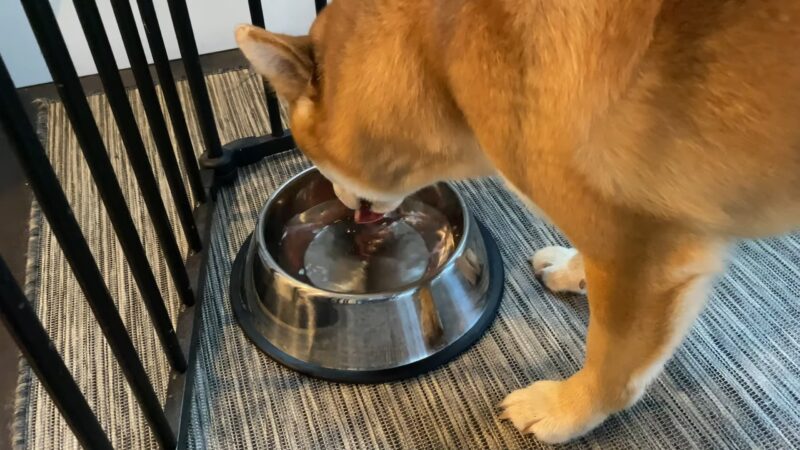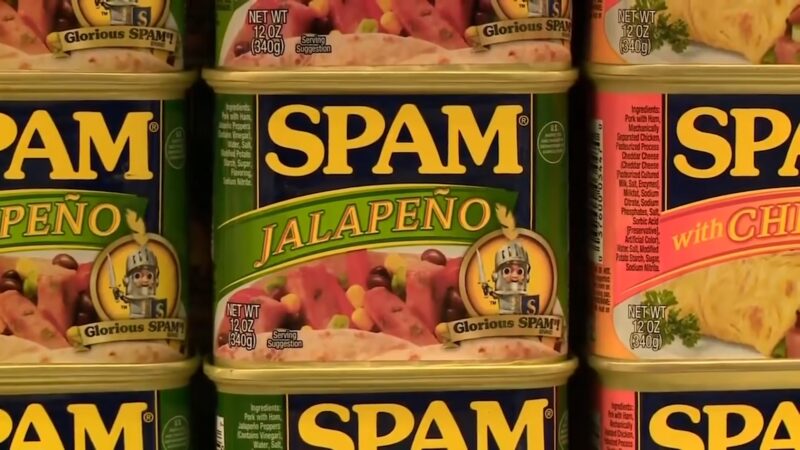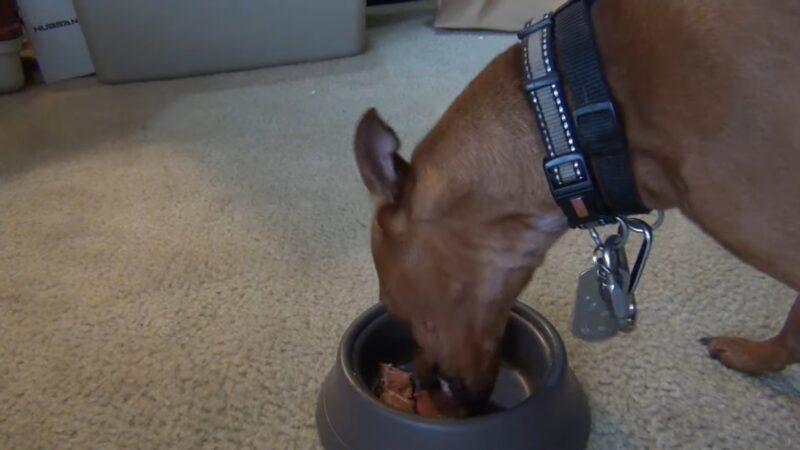As dog owners, we often wonder which human foods are safe to share with our pets. Spam, a popular canned meat, is found in many homes, but it can cause serious health problems if fed to dogs.
Today, we will talk about can dogs eat spam, and whether it comes with dangers. We will look at its high salt and fat levels, as well as the preservatives and sugar it contains, and how these can harm your dog’s health.
Knowing these risks is important to keep your dog healthy and safe.
1. Salt Poisoning

Spam is notoriously high in salt, a fact that can have severe repercussions for dogs. Dogs’ bodies are not designed to handle high levels of sodium as efficiently as humans.
When dogs eat spam, it can lead to a condition known as salt poisoning, which is as dangerous as it sounds.
Why Dogs are More Vulnerable
Dogs’ bodies are less efficient at processing sodium than humans, so even a small amount of excess salt can be harmful.
The high salt content in Spam can quickly lead to dehydration, making the dog’s body work harder to flush out the excess sodium, which can strain their kidneys.
If you suspect your dog has consumed a large amount of Spam or is showing any signs of salt poisoning, contact your veterinarian immediately.
Keep fresh water available to prevent dehydration, but do not force your dog to drink excessively, as it could cause further complications.
Symptoms
- Excessive Thirst: One of the first signs of salt poisoning in dogs is an unusual increase in thirst. This is the body’s way of trying to balance the high sodium levels.
- Loss of Coordination: High salt levels can disrupt brain function, leading to a noticeable loss of coordination in dogs. This may manifest as difficulty in walking or standing.
- Stomach Upset: Dogs may exhibit symptoms like vomiting or diarrhea due to the irritant nature of salt on their gastrointestinal tract.
- Tiredness: Elevated sodium levels can cause lethargy or unusual tiredness in dogs as their bodies struggle to cope with the imbalance.
- Tremors: In more severe cases, dogs might experience tremors or seizures, which are alarming signs of neurological impact due to salt poisoning. In extreme cases, salt poisoning can lead to coma, severe kidney damage, or even death, making it imperative to keep Spam away from dogs.
2. Pancreatitis

The high-fat content in Spam is another reason it’s unsuitable for dogs. When dogs eat spam, especially those not accustomed to high-fat diets, can suffer from pancreatitis, an inflammation of the pancreas that can be triggered by eating fatty foods.
Why High-Fat Foods Trigger Pancreatitis
Dogs’ digestive systems are not designed to handle large quantities of fat. When dogs eat spam, their pancreas has to work harder to produce the enzymes needed for digestion.
This overactivity can lead to inflammation, causing the pancreas to malfunction and struggle with processing not only fats but also other nutrients.
Long-Term Health Risks
Pancreatitis can lead to serious health complications, including chronic pain, diabetes, and other digestive disorders. In severe cases, it can be life-threatening, requiring hospitalization and intensive care.
Prevention
To prevent pancreatitis, avoid feeding your dog high-fat foods like Spam. Stick to dog-safe, low-fat treats, and consult with a vet if you have concerns about your dog’s diet.
Regular check-ups can help catch any early signs of digestive issues, ensuring your dog remains healthy and comfortable.
Symptoms
- Stomach Upset: Dogs with pancreatitis often show signs of abdominal distress, including vomiting and diarrhea.
- Intense Abdominal Pain: They may appear visibly uncomfortable, with pain evident when their abdomen is touched.
- Fever: An elevated body temperature is a common sign of infection or inflammation, as seen in pancreatitis.
- Tiredness: A dog suffering from pancreatitis will often be lethargic and show little interest in activities they usually enjoy. Decreased Appetite: Loss of appetite is another red flag, especially in dogs that are normally enthusiastic eaters.
- “Downward Dog” Position: In severe cases, dogs may adopt a characteristic “prayer” position with their front end down and hind end up, trying to relieve abdominal discomfort.
Continual exposure to high-fat foods like Spam can lead to chronic pancreatitis, which can have long-term effects on a dog’s health and quality of life.
The Long-term Impact of Pancreatitis Chronic pancreatitis can lead to irreversible damage to the pancreas, affecting its ability to produce essential digestive enzymes and hormones. This damage can result in digestive problems and even diabetes.
Dogs with a history of pancreatitis may require lifelong dietary management and veterinary care, emphasizing the importance of avoiding high-fat foods like Spam.
3. Unhealthy Preservatives and Sugar Content

In addition to its high salt and fat content, Spam is laden with preservatives and sugars that are detrimental to a dog’s health. These additives, while extending the shelf life and enhancing the flavor of the product for human consumption, can pose serious health risks to dogs.
- Weight Gain and Obesity: If dogs eat spam, or any foods high in sugars and fats, are at a higher risk of becoming overweight or obese. Obesity in dogs can lead to a myriad of health issues, including joint problems, heart disease, and diabetes.
- Increased Risk of Diabetes: The sugar content in Spam can contribute to an increased risk of diabetes in dogs, a chronic condition that can significantly impact their quality of life and require lifelong management.
- Dental Issues: Sugary and processed foods like Spam can also lead to dental health problems in dogs, including cavities, tooth decay, and gum disease. Dental issues can be painful and lead to further health complications if not addressed. The preservatives used in Spam, such as sodium nitrite, can also have adverse effects on a dog’s health, making it an unsuitable choice for canine diets.
The Dangers of Different Flavors of Spam
While some might consider flavored varieties, like Spam Lite, Turkey, or Low Sodium, as healthier alternatives for dogs, these options are still fraught with risks. Each variant of this food carries its own set of unhealthy additives, making them inappropriate for canine consumption.
Why Flavored Spam Is Unsafe
| Spam Variant | Key Characteristics | Health Risks for Dogs |
|---|---|---|
| Spam Lite | Marketed as a healthier option due to its lower fat content, but still high in salt and contains harmful preservatives. | High salt content, harmful preservatives. |
| Turkey Spam | Appears leaner but includes seasonings and additives harmful to dogs, potentially causing gastrointestinal upset or allergic reactions. | Gastrointestinal upset, allergic reactions due to additives. |
| Low Sodium Spam | Lower in salt but still contains enough sodium to be risky, along with high fat and preservative levels. | High sodium, fat, and preservatives. |
What to Do If Your Dog Eats It?

If your accidentally dogs eat spam, taking quick and appropriate action is essential to reduce the risk of health issues. Here are the steps you should follow:
Provide Fresh Water Immediately
Offering your dog plenty of fresh water is one of the first things you should do. Water helps to dilute the excess sodium in the bloodstream and supports the kidneys in flushing out harmful substances. Ensure that your dog drinks, but don’t force them. Gentle encouragement is often sufficient.
Monitor for Symptoms
Keep a close eye on your dog for any signs of distress. Watch for symptoms like vomiting, diarrhea, excessive thirst, lethargy, abdominal pain, or unusual behavior.
Recognizing symptoms of salt poisoning or pancreatitis early on can be crucial in managing these conditions before they become more serious.
Note any changes in your dog’s behavior, such as unusual restlessness or sluggishness, which may indicate that something is wrong.
Consult a Veterinarian
If you notice any adverse reactions, or if your dog has consumed a large amount of Spam, it’s important to contact your veterinarian right away.
They can advise on the best course of action, which may include inducing vomiting, providing fluids, or other treatments. Do not attempt home remedies without consulting a professional, as improper treatment could worsen the situation.
Long-Term Monitoring
After your dog has consumed Spam, continue to monitor their health over the following days. Behavioral changes, such as increased lethargy, reduced appetite, or changes in bathroom habits, could signal a delayed reaction to the high salt or fat content.
Make note of any symptoms, even if they seem mild, and report them to your vet.
Regular health check-ups can help ensure any potential long-term effects, such as digestive issues or pancreatic strain, are addressed promptly.
Consult a Veterinarian
If you notice any adverse reactions or if your dog has consumed a significant amount of Spam, it’s imperative to seek veterinary advice. They can provide guidance on any necessary interventions or treatments.
Long-Term Monitoring After an incident involving Spam consumption, it’s wise to monitor your dog’s health over the following days.
Behavioral changes, such as increased lethargy, loss of appetite, or unusual bathroom habits, could indicate a delayed reaction to the high salt or fat content.
Consistent monitoring and regular health check-ups can help ensure any long-term effects are addressed promptly.
Why Canned Meat Isn’t Recommended
Canned meats, in general, are not ideal for dogs due to their high salt content, preservatives, and often high-fat levels. While they might seem like convenient feeding options, they can pose similar risks to those associated with Spam.
Healthy Alternatives
Instead of feeding your dog processed meats like Spam, there are much safer and healthier options to consider.
Here are a few alternatives that can provide essential nutrients without the risks:
| Healthy Alternative | Description |
|---|---|
| Cooked, Unseasoned Fresh Meat | Cooked chicken, turkey, or beef without salt. Bone-free. |
| Store-Bought Canned Dog Food | Balanced nutrition without excess salt. Check labels. |
| Plain, Cooked Vegetables | Soft, unseasoned veggies like carrots and pumpkin. |
| Homemade Dog Treats | Treats with safe ingredients like peanut butter and oats. |
| Commercial Freeze-Dried Dog Food | Raw ingredients, rehydrate easily. No added sugars. |
FAQs
Summary
Dogs eating Spam, even in small amounts or as an occasional treat, is not a good idea because it can cause serious health problems. All types of Spam are high in salt, unhealthy fats, preservatives, and sugars, which can be harmful to your dog.
If your dogs eat spam accidentally, make sure to give them fresh water right away, watch for any symptoms, and contact your vet.
Instead of canned meats like Spam, choose healthier options such as cooked, unseasoned fresh meat or specially made canned dog food.







